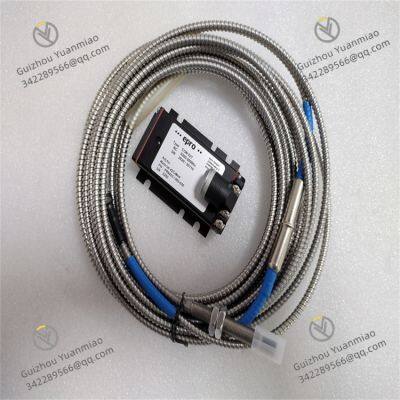Product Description
I. Overview
The combination of EPRO PR6423/003-010-CN and CON021 is a precision set elaborately designed for monitoring the operating status of industrial equipment. Among them, PR6423/003-010-CN, as an eddy current sensor, is mainly responsible for accurately perceiving the key operating parameters of the equipment; CON021, as a preamplifier, undertakes the important responsibilities of signal conditioning and transmission. The two work closely together, capable of providing stable and reliable monitoring data for various industrial equipment, and play an indispensable role in the industrial production process.
As a well-known brand in the industry, EPRO has always been committed to the innovation and research of industrial monitoring technology. With profound technical accumulation and persistent pursuit of quality, it has established an excellent reputation in the field of industrial monitoring. This combination of PR6423/003-010-CN and CON021 is the crystallization of the brand's technical strength and professionalism, aiming to meet the strict requirements of high-precision monitoring of equipment operating status in many industries such as petrochemicals, electric power, and metallurgy, and to ensure the safe and stable operation of industrial production.
II. Technical Parameters
(1) Parameters of PR6423/003-010-CN Sensor
Range: Its range is set to ±2mm. This range is carefully designed and suitable for monitoring displacement, vibration and other parameters of key parts of various industrial equipment. Whether it is the radial vibration monitoring of the rotating machinery shaft system or the displacement measurement of reciprocating equipment components, this range can accurately cover, providing reliable data support for the accurate evaluation of the equipment's operating status.
Sensitivity: The sensitivity reaches 4V/mm, which means that the sensor can respond sensitively to extremely small physical changes. Even if there are slight fluctuations in the equipment's operating parameters, it can quickly capture and convert them into recognizable electrical signal output, ensuring the timeliness and accuracy of the monitoring data, enabling operators to detect potential problems in the equipment's operation in a timely manner.
Rated Air Gap: The rated air gap is 3.0mm. This parameter is determined based on a large number of practical application experiences and in-depth research on the operating characteristics of different industrial equipment. Under this air gap condition, the sensor can maintain the optimal sensing distance from the measured object, ensuring the stability and accuracy of the measurement signal, and effectively avoiding signal interference or measurement errors caused by improper air gaps.
Parameters related to the measured object:
Material Requirements: It is suitable for metal materials, with 42CrMo4 steel as the reference material. This is because such metals have good conductivity and stability, which can perfectly match the induction principle of the sensor, ensuring the reliability and consistency of the measurement results. In industrial production, most components of key equipment, such as shafts and gears, are made of metal materials, so this sensor can be widely used in the monitoring of various industrial equipment.
Shape Adaptability: It can effectively measure the measured objects of various shapes such as shafts, planes, and measuring discs on shafts. This wide shape adaptability allows the sensor to be easily installed and used in the monitoring applications of different types of industrial equipment. Whether it is a conventional cylindrical shaft component or a complex-shaped mechanical part, accurate measurement can be achieved.

Size Requirements: For the measuring disc on the shaft, its height is required to be 40mm; for the diameter of the measured shaft, it is required to be not less than 80mm. These size requirements are determined based on the sensing characteristics of the sensor and the actual structural characteristics of industrial equipment, ensuring that the sensor can perform at its best and obtain accurate measurement data under the condition of meeting the size requirements.
Environmental Adaptability Parameters:
Operating Temperature Range: The operating temperature range is - 35°C to + 180°C, which can adapt to various harsh industrial environmental temperature conditions. Whether in high-temperature smelting workshops or cold outdoor workplaces, the sensor can work stably, not affected by temperature changes, and continuously provide reliable data for monitoring the equipment's operating status.
Withstand Temperature: It can withstand an instantaneous maximum temperature of + 380°C, and the transportation and storage temperature range is - 40°C to + 70°C. This means that during the installation, transportation, and long-term storage of the equipment, the sensor can maintain good performance, will not be damaged due to temperature fluctuations, and greatly improves the applicability and service life of the product.
Vibration and Impact Resistance: At 25°C, it has good vibration and impact resistance, and can withstand 4g vibration and impact at 60Hz. This enables the sensor to work stably in the complex mechanical vibration and possible accidental impact environment of the industrial site, ensuring the accuracy and continuity of measurement data, and effectively avoiding measurement errors or equipment failures caused by external vibration and impact.
Pressure Resistance: The sensor and cable have a certain pressure resistance capacity, which can withstand 2bar pressure. This characteristic enables it to work normally in some industrial application scenarios with pressure environments, such as the monitoring of petrochemical pipeline equipment, without being interfered by pressure factors, ensuring the reliability of equipment operating status monitoring.
(2) Parameters of CON021 Preamplifier
Input and Output Characteristics:
Input: It is specially adapted to the turbine sensor PR6422/... ~ PR6426/... series, and perfectly matches the PR6423/003-010-CN sensor. Through a specific interface connection method, it can accurately receive the original signal from the sensor, laying the foundation for subsequent signal processing and transmission.
Output: The output signal is an AC voltage signal superimposed on a DC voltage, which is proportional to the shaft vibration. This output mode can intuitively reflect the vibration state of the equipment, facilitating the analysis and processing of the subsequent monitoring system. At the same time, the preamplifier has open-circuit, short-circuit protection and reverse protection functions, effectively preventing equipment damage caused by line faults or connection errors, and improving the reliability and stability of the system.
Output Voltage Range:
Linear Range: When the supply voltage is - 24V, the linear range of the output voltage is - 4V to - 20V. Within this range, the output voltage has a good linear relationship with the vibration state of the equipment, which can provide accurate and stable signals for the monitoring system, facilitating operators to accurately judge the operating state of the equipment.
Maximum Range: The maximum range of the output voltage is - 1V to - 22V. This wide output range can adapt to changes in equipment vibration signals under different working conditions. Even in extreme cases of equipment operation, it can ensure the effective output of signals, providing sufficient data support for equipment fault diagnosis.
Reference Voltage: The reference voltage is - 12V (symmetrical measurement range at both ends). This reference voltage provides a stable benchmark for signal processing and analysis, helping to improve measurement accuracy and system stability.
Electrical Performance Parameters:
Internal Resistance: The internal resistance is 100kΩ. This internal resistance parameter is carefully designed to ensure good impedance matching with the subsequently connected monitoring equipment during signal transmission, reducing signal attenuation and distortion, and ensuring the quality and stability of signal transmission.
Response Time: The response time is 15μs, which can quickly respond to the signal input by the sensor and timely output the processed signal to the monitoring system. In the case of rapidly changing operating status of industrial equipment, such a short response time can ensure that operators obtain the latest operating information of the equipment in a timely manner, providing strong support for early warning and timely handling of equipment faults.


ROCKWELL T8800C PD8800 PCB130100 Trusted 40 Channel Analogue Input FTA
FOXBORO RH101AA High-Performance Pressure Transmitter
WOODWARD 5437-1067A Speed Control Plate
Bently Nevada 289761-01 Emergency Shutdown Device (ESD)
Bently Nevada 3701/55 Emergency Shutdown Device (ESD)
Bently Nevada 136719-01 Earthing I/O Module
Bently Nevada 135785-01 System Display
Bently Nevada 3500/91 EGD Communication Gateway Module
Woodward 8200-1508 Digital Control Module
WOODWARD 5437-1119 High-performance control components
Woodward 8402-271 Speed Regulator
Woodward 8511-144 Actuator Governor Control Module
 yezi
Hi there! Welcome to my shop. Let me know if you have any questions.
yezi
Hi there! Welcome to my shop. Let me know if you have any questions.


